
Your Peace Lily isn’t thriving and you don’t know what to do? Don’t worry, this article has you covered. We’ll explain all the main aspects of Peace Lily care, Peace Lily water and light requirements to propagation and pruning.
| Botanical Name (Latin Name/Scientific Name): | Spathiphyllum Wallisii |
| Common Name: | Peace Lily |
| Light: | low light tolerant (50 Lux – 750+ lux) |
| Watering: | once the top half of the soil is dry |
| Soil: | well-draining mix |
| Repotting: | Once a year |
| Temperature: | 75F to 85°F (23°C to 30°C) |
| Humidity: | 25% to 50%, but it adapts well to any humidity |
| Toxicity for Pets: | Yes (mouth, tongue, and lips burning and irritation, excessive drooling, vomiting, difficulty swallowing) |
| Toxicity for Humans: | Yes (irritation to the lips, mouth and tongue, stomach upset, a skin rash or irritation) |
| Propagation: |
|
| Pruning: | Prune dead or diseased growth or when you want the plant to branch out |
Light Requirements
| Minimal amount of light: | 50 Lux (5 FC) |
| Optimal amount of light: | 750+ lux (75+ FC) |
| Direct sun tolerance: | 1-2 hours |
| Category: | low-light tolerant |
One of the most important requirements to grow and care for Peace Lily is the right amount of light. Even though they tolerate low light levels, Peace Lily flowers only with a minimum of bright indirect light (ideally over 10,000 lux). If you can provide it with a few hours of light direct sunlight each day (early in the morning or late in the afternoon), even better. If you grow and care for Peace Lily indoors, place the plant near a window that receives plenty of indirect light during the day. For example, an east-facing window is a good option because of the morning sun.
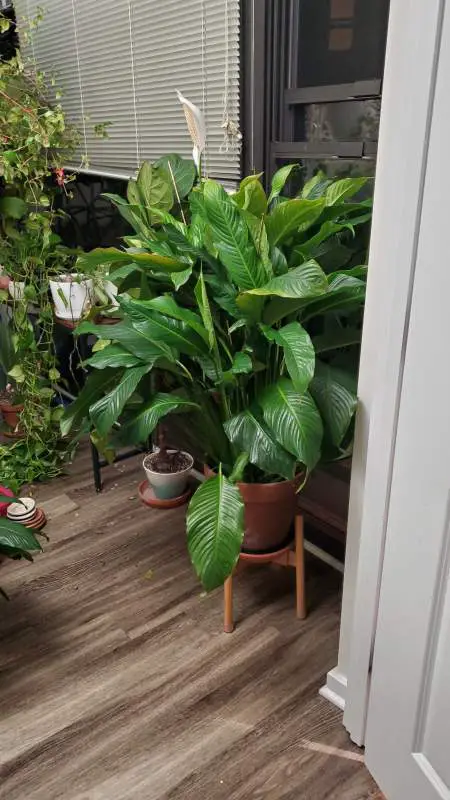
Mr. Houseplant’s Peace Lily with dark green leaves thriving
The more light they get, the more they will photosynthesize, the faster they will grow and the healthier and happier they will be.
Water Needs
When it comes to watering, a Peace Lily will let you know when it’s time for a drink. The leaves will begin to droop when the plant is thirsty. Simply water your Peace Lilies thoroughly and then allow the top inch or two of soil to dry out before watering again. If you water the plant-Peace Lily and it’s still droopy after 24 hours, that means that it’s likely been overwatered. Wait for the soil to dry out fully to the bottom of the pot, and then water again. After you repeat several rounds of watering like this, the plant should stop being droopy.
If you wait too long to water your indoor plant, the soil can become too dry and the Peace Lily’s root system will start dying. If you water your Peace Lilies too much, the soil can become oversaturated and damage the Peace Lily’s root system.
The best type of water to use is rainwater or distilled water. However, you can also use tap water to water this plant.
Humidity Needs
Peace Lilies prefer medium humidity (25% to 50%). Still, they can thrive in both low and high-humidity environments as long as they have enough light and are watered properly. If the humidity is low (under 20%), Peace Lilies will lose water through their leaves more quickly, so you will need to water them more often. If the humidity is high, Peace Lily plants will lose water more slowly, so you won’t need to water them as often.
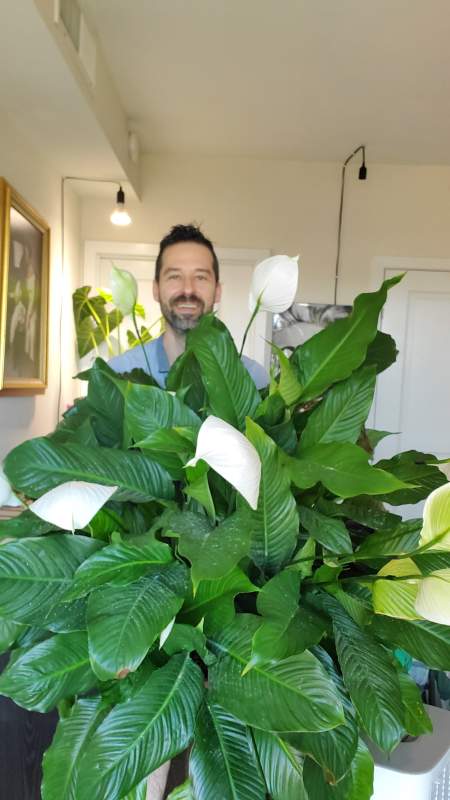
Good care for Peace Lilies leads to the beautiful plant with white flowers and dark green leaves. If caring for Peace Lily is regular, it can be a very low-maintenance plant.
Temperature Requirements
The ideal temperature that Peace Lilies need ranges from 75°F to 85°F (23°C to 30°C). Peace Lilies like lower temperatures more than some other tropical species. Whereas other tropical species get visible leaf damage at 52°F /11°C, Peace Lilies will only experience slower growth. Exposure to temperatures below 45°F /7°C will result in leaf damage. For some Peace Lilies varieties, such a low temperature can be fatal. Since your plant is inside your home or office, the room temperature will suit it just fine.
Fertilizing
You only need to fertilize your Peace Lilies if you don’t repot them annually. Repotting provides fresh potting soil full of new nutrients. If you do want to fertilize your Peace Lily, make sure to do it only if it’s actively growing. If you fertilize your indoor plant when it stops growing, nutrients will accumulate in the soil as the plant is not using them and will start burning the roots and damaging your Peace Lily.
Dyna Gro is a good choice if you want to fertilize during the growing season. It contains all 16 essential minerals that Peace Lilies need. You can also fertilize your Peace Lily using any fertilizer with an NPK ratio of 3:1:2 during the growing season.
Make sure to follow the instructions on the fertilizer packaging, as each fertilizer will have a different frequency and amount.
Although fertilizer is important, it is not a replacement for light. Your Peace Lily will not bloom without the proper amount of light.
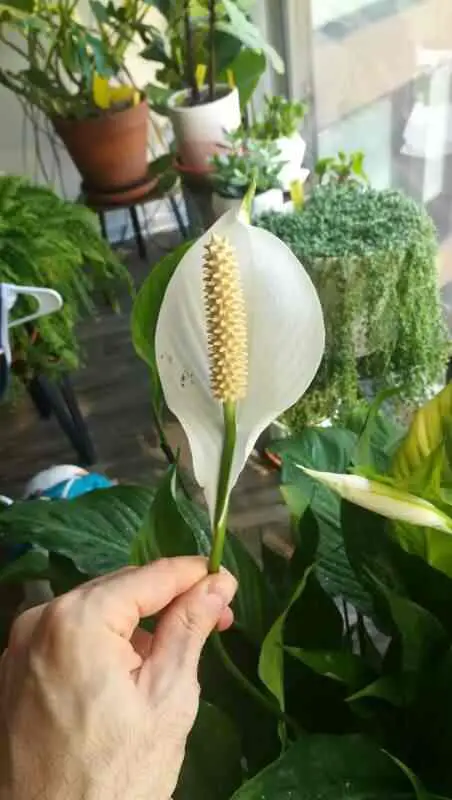
My Peace Lily enjoying its environment
Soil
A well-draining soil is the best for a Peace Lily plant. Peace Lilies prefer well-draining, nutrient-rich soil with at least 20 to 30% inorganic matter, so the roots can get oxygen. The potting mix should be loose and airy to allow the roots of the Peace Lily to breathe.
Although I am generally not a big fan of straight out-of-the-bag potting soil as they retain too much water, Mother Earth Groundswell is an exception. It’s an excellent well-draining potting mix.
If you like to mix your own soil, you can use Proven Winners and mix 3 parts Proven Winners, 1 part perlite, and 1 part bark. When you add amendments with larger particle sizes, such as coarse perlite, bark, coarse sand, etc, you create so-called macro pores, which contain oxygen, reducing the chances of root rot. It’s an excellent potting mix for the plant.
Repotting
This is how to repot a Peace Lily plant:
- First, prepare one size bigger container and fill one-third with fresh soil.
- Then, carefully take out your Peace Lily
- Gently loosen the root ball and check the state of the roots
- If the roots are mushy and smelly, prune them
- Finally, place the plant into its new pot, fill it up with soil and lightly press it around the Peace Lily.
- Water it and let it rest
You should repot your plant once a year to give it fresh nutrients and keep the soil from getting compacted. Remember that soil needs to have enough oxygen, so ideally your pot should have a drainage hole. This way, any excess water can drain out and the roots won’t sit in the water without oxygen for too long and rot.
If you are going to repot your plant, it is best to only do a pot up rather than a full repot. A full repot is removing all of the soil and replacing it with fresh new soil. Full-repotting is excellent for more experienced plant parents, but it can be stressful for the plant and it may take a few days or weeks for it to recover. I generally advise newbie plant parents to do a pot-up rather than full repotting.
How Do I Know If My Peace Lily Needs Repotting
Here are the top signs that your peace lily might need repotting:
- Sign 1: the roots are coming out the bottom of the pot
- Sign 2: the soil is drying out much faster than it used to (i.e. 3 days as opposed to 7-8 days)
- Sign 3: there is not a lot of soil left in the pot because the roots have consumed most of it
If you’re unsure, pull the whole plant out of the pot and inspect the roots. If all you see is a large root ball and not a lot of soil, it’s time to repot.
Even if you don’t experience any of the aforementioned situations, you should still repot your plant once a year. That way you’ll be removing nutrient-poor, compacted soil, and providing fresh soil, with oxygen and lots of nutrients.
Toxicity To Humans
Peace Lilies are toxic to humans. California Poison Control System (CPCS) states that this plant contains oxalate crystals that may cause lip, mouth, and tongue irritation. Sometimes breathing problems and swelling in the throat are also possible.
Ann King Filmer, Ph.D. Plant Scientist from the University of California, in the publication “Safe and Poisonous Garden Plants” from October 2012 confirms that Peace Lily can also cause stomach upset, and a skin rash or irritation.
Toxicity To Pets
Peace Lilies are toxic to pets. If your pet swallowed a part of a Peace Lily it can cause oral irritation, intense mouth, tongue, and lips burning and irritation, excessive drooling, vomiting, and difficulty swallowing according to the American Society For The Prevention Of Cruelty To Animals (ASPCA).
Pruning
In general, you don’t need to prune your Spathiphyllum if it has healthy green foliage and stems. You should only prune sick, dead, or dying parts of a plant. In case you need to prune, how you’ll prune depends on the plant’s part that needs pruning:
- If you need to prune a dead or diseased stem, you should do it at the base of the stem, cutting it off as close to the bottom as possible.
- After a peace lily flower dries out and dies, the whole flower stalk will dry out. Once that happens you can prune the flower stalk at the base, as low as possible. Or if it’s dry enough, you will be able to just pull it out from the plant with your hand.
- You should also prune dry/dead leaves. If only the leaf tips are brown, you can just cut the tip off. However, if the whole leaf is dry and crispy, you can cut off the whole leaf.
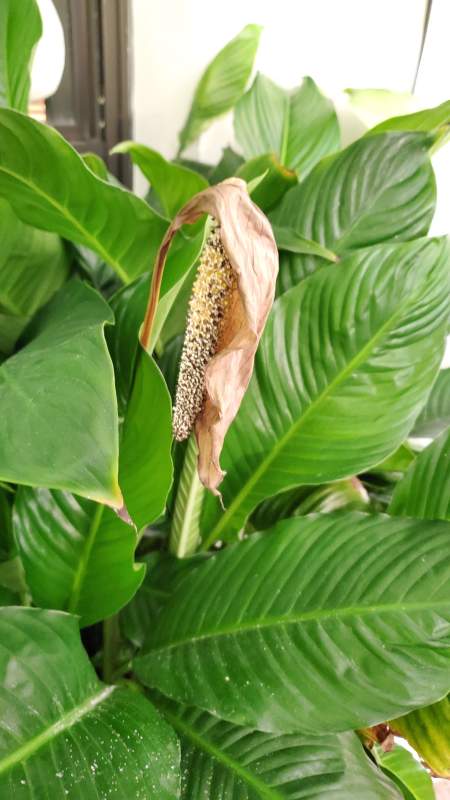
A dried-out flower on Peace Lily. Peace Lilies usually have beautiful white flowers.
Propagation
You can propagate a Peace Lily by division or through seed propagation. Unlike a lot of indoor plants, you cannot propagate the Peace Lily plants by taking a leaf or stem cutting. You can propagate Peace Lilies in a few simple steps (you can only do this if your plant has several clumps of leaves/several plants in one pot):
- Prepare new pots and fill one-third of them with fresh potting soil.
- Remove the plant from its pot and loosen the soil around the roots. Don’t worry if you cut off some of the roots in the process.
- Identify the point of division. Try to identify where the roots of 2 clumps of leaves connect
- Separate the two plants/clumps. With smaller plants, you might be able to just pull the roots apart by hand, but with larger plants with thicker roots, you might need to cut them. You’ll need a serrated knife, especially if it’s a root ball. Sterilize it before you cut.
- Once you’ve divided the plants, put these new Peace Lilies in the previously prepared pots. Fill with soil. Don’t forget to water. Put new Peace Lilies in a space with plenty of bright, indirect light.
You shouldn’t worry if the leaves on your houseplants become droopy soon after you separate and repot them. This is just an initial shock reaction that will go away once the indoor plants get accustomed to the new surroundings which are not Peace Lilies’ native environment.
Since I have a huge, beautiful Peace Lily with 11 white flowers, I was curious to find out how I can propagate by seeds, especially since there isn’t much info about it online. If you’d like to find out more about how to pollinate a peace lily, check out the blog post I wrote.
You also don’t want to miss the peace lily pollination video below:
When Should I Propagate A Spathiphyllum
Any season is good for Peace Lily propagation. Why? As long as it’s warm enough and there is enough light (or grow lights), you’re good to go. If it’s warm enough in your home for you, it will be warm enough for your Peace Lilies.
FAQs about Peace Lily
Are Peace Lilies Hard to Care For?
Care for Peace Lilies is not hard. They are easy to grow and are tolerant of a wide range of lighting conditions. These Lilies prefer bright, indirect light but will also do well in low-light conditions, as they can tolerate extremely low light levels. Do note that in light that is low, they will grow slower.
How Fast do Peace Lilies Grow?
Peace Lilies grow relatively slowly, typically only an inch or a few inches per year in height. However, they can grow more quickly if they are provided with optimal conditions, primarily a lot of light.
How Many Types of Peace Lilies Spathiphyllum Exist?
There are more than 40 known types of Peace Lilies Spathiphyllum, although only a few are commonly cultivated as houseplants. They come in different sizes.
Among the smaller ones, the most common are Spathiphyllum ‘Power Petite’ and Spathiphyllum Wallisii.
When it comes to the mid-sized ones, the most popular is Spathiphyllum ‘Mauna Loa Supreme’. Following behind are Spathiphyllum ‘Clevelandii’, Spathiphyllum ‘Mojo Lime’, and Spathiphyllum ‘Domino’.
The largest Peace Lily that you can buy is Spathiphyllum ‘Sensation’. It can grow up to 6 feet with 20-inch-long leaves. Its smaller version is ‘Sensation Mini.”
Why do My Peace Lilies Have Yellow Leaves?
There are several reasons why the Peace Lilies might have yellow leaves. It could be due to regular senescence (leaf loss), insufficient moisture, overwatering, a nutrient deficiency, or pests. You can diagnose this based on the way the leaves are yellowing and the care the plant is getting.
If you know your plant is getting sufficient light and the watering is correct, it’s likely due to regular loss of older leaves, pests, or nutrient deficiency. If the leaves are yellow and wilted, it is likely that the plant is either overwatered or underwatered. If the leaves have fading yellowing on the edges, you may have pests.

Pest damage on a Peace Lily leaf (in this case spider mites)
It’s also possible that your plant cannot support any more leaves due to the amount of light it’s receiving. Once it reaches the maximum number of leaves with the current amount of light, lower leaves will start yellowing and dying. This would be considered normal leaf senescence.
Diagnosing yellow leaves on the Peace Lilies Spathiphyllum is a complex issue. It’s important to always look at the overall environment the plant is in (light, humidity, watering, fertilizing, etc.) and the care Peace Lily is receiving in order to diagnose properly. If you have any doubts about how to take care of your beautiful Peace Lily, feel free to book a consultation with me.
Why do My Peace Liles Plants Have Dry Leaves?
There are several reasons why a Peace Lilies might have dry leaves. It could be due to sunburns (because the plant has been exposed to the direct sun), insufficient humidity, insufficient watering, a nutrient deficiency, or it could be normal leaf loss.
Brown Tips on Peace Lilies
If you notice brown tips on your Peace Lilies, it is likely due to one of four things:
- too little water,
- too much fertilizer,
- low humidity or
- soil compaction.
Before trying to solve this, know that brown tips are not a problem, they are just an aesthetic issue. Feel free to cut them off and enjoy the beauty of your plant. Plants are not perfect in nature, they shouldn’t be perfect in our indoor garden.
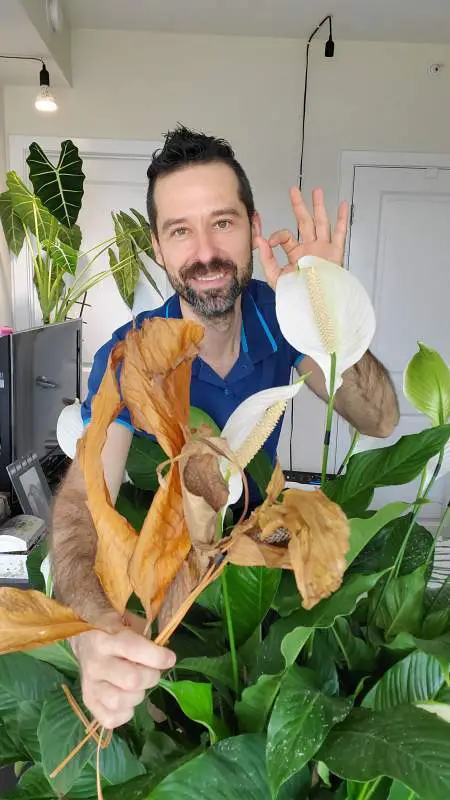
Leaves yellowing among white flowers is a natural process
Peace Lilies prefer getting enough water, so if they don’t get it the leaves will start to turn brown and wilt. Make sure to water your houseplants regularly.
If you are using too much fertilizer, the salts in the fertilizer can build up and burn the tips of the leaves.
If you have very low humidity (under 20%), use a humidifier near the plant to increase humidity.
If the soil is compacted, this can also cause brown tips. Do a full repot of your plant by removing all old soil and replacing it with fresh new soil.
If your Peace Lilies develop brown leaf tips, try one of these solutions and see if it helps!
Have More Questions about Peace Lilies?
If you want to learn how to get a peace lily to flower, I’ve already written a full blog post about it.
Nonetheless, if you’re having doubts or more questions about caring for Peace Lilies, let me know in the comments below this article. You can also schedule a virtual one-on-one consultation with me and get the help you need.
Always happy to help!
Yours Truly,

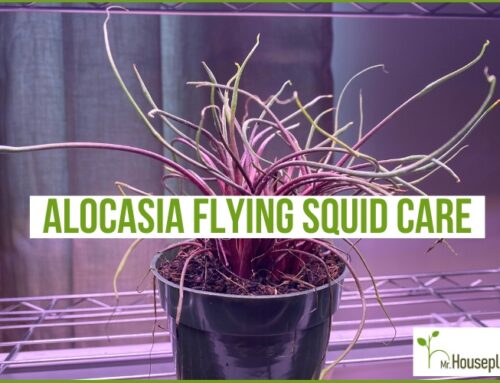

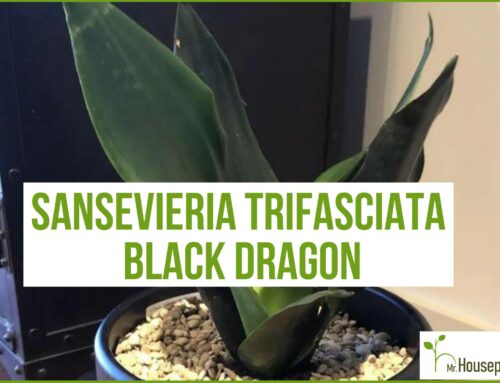

I do not like the mess of the pollen. When a flower opens, can I remove the pollen stem and just enjoy the flower
I understand, some people are also allergic to pollen. And it does make a mess :) Yes, you can cut off the pollen stem.